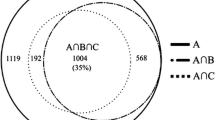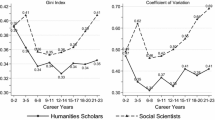Abstract
This paper reports the results of two studies on the development of scientific talent among the scientific elite: finalists in the Westinghouse Science Competition and members of the National Academy of Sciences (NAS). Sampling four cohorts of finalists, we examined whether these gifted teenagers actually do go on to be the best scientists of the next generation by coding education and career outcomes. Finalists were quite successful and stayed mostly within science and medicine for their career choice. A rather high—although marginally unequal—portion of male (91%) and female (74%) finalists earned a doctoral degree. Women were also more likely to change to non-scientific professions than men. Among the most compelling findings from the NAS study were: age that scientific talent was recognized by self and others was an important predictor of early publication, which in turn was an important predictor of lifetime productivity. Growth curve analyses suggested a cubic model best fit productivity data over time. Moreover, in both samples there was an association between scientific achievement and recent immigrant status. Various theoretical models are discussed as possible explanations for the developmental, gender, and immigrant-status findings on scientific talent.

Similar content being viewed by others
References
Baron-Cohen S., Wheelwright S., Stone V., Rutherford M. (1999) A mathematician, a physicist, and a computer scientist with Asperger syndrome: Performance on folk psychology and folk physics tests Neurocase 5: 475–483.
Baron-Cohen S., Wheelwright S., Skinner R., Martin J., Clubley E. (2001). The Autism-Spectrum Quotient (AQ): Evidence from Asperger syndrome/high-functioning autism, males and females, scientists and mathematicians Journal of Autism & Developmental Disorders 31: 5–17.
Baron-Cohen S., Bolton P., Wheelwright S., Short L., Mead G., Smith A., Scahill V. (1998) Autism occurs more often in families of physicists, engineers, and mathematicians Autism 2: 296–301.
Bayer A. E., Dutton J. E. (1977) Career age and research–professional activities of academic scientists: Tests of alternative non-linear models and some implications for higher education faculty policies Journal of Higher Education 48: 259–282.
Benbow C. P., Minor L. L. (1986) Mathematically talents students and achievement in the high school sciences American Educational Research Journal 23: 425–436.
Benbow C. P., Stanley J. C. (1982). Consequences in high school and college of sex differences in mathematical reasoning ability: A longitudinal perspective American Educational Research Journal 19: 598–622.
Benbow C. P., Lubinski D., Shea D. L., Eftekhari-Sanjani H. E. (2000) Sex differences in mathematical reasoning ability at age 13: Their status 20 years later Psychological Science 11: 474–480.
Berger J. (1994) The Young Scientists: America’s Future and the Winning of the Westinghouse. Reading, MA: Addison-Wesley Publishing.
Berliner, D. C. (2001). Averages that hide the true extremes. Washington Post, January 28, 2001.
Cameron P. A., Mills C. J., Heinzen T. E. (1995) The social context and developmental patterns of crystallizing experiences among academically talented youth Roeper Review 17: 197–200.
Cole J. R. (1987) Women in science. In: Jackson D., Rushton P. J. (Eds) Scientific excellence Beverly Hills, CA: Sage (pp. 359–375).
Cole J., Cole S. (1973) Social stratification in science Chicago, IL: University of Chicago Press.
Cole J. R., Zuckerman H. (1987) Marriage, motherhood, and research performance in science Scientific American 256: 119–125.
Cole S. (1979) Age and scientific performance American Journal of Sociology 84: 958–977.
Dennis W. (1956) Age and productivity among scientists Science 123: 724–725.
Dennis W. (1966) Creative productivity between the ages of 20 and 80 years Journal of Gerontology 21: 1–8.
Diamond A. M. (1986) The life-cycle research productivity of mathematicians and scientists Journal of Gerontology 41: 520–525.
Farmer H. S., Wardrop J. L., Rotella S. C. (1999). Antecedent factors differentiating women and men in science/nonscience careers Psychology of Women Quarterly 23: 763–780.
Feist G. J. (1993) A structural model of scientific eminence Psychological Science 4: 366–371.
Feist G. J. (1997) Quantity, impact, and depth of research as influences on scientific eminence: Is quantity most important? Creativity Research Journal 10: 325–335.
Feist, G. J. (2006). Foundations for the psychology of science: With a view toward the origins of the scientific mind. New Haven, CT: Yale University Press.
Feist G. J., Barron F. (2003) Predicting creativity from early to late adulthood: Intellect, potential, and personality Journal of Research in Personality 37: 62–88.
Feist G. J., Gorman M. E. (1998) Psychology of science: Review and integration of a nascent discipline Review of General Psychology 2: 3–47.
Freeman C. (1999) The crystallizing experience: A study in musical precocity Gifted Child Quarterly 43: 75–85.
Gardne H. (1993) Creating minds: An anatomy of creativity New York: Basic .
Hedges L. V., Nowell A. (1995) Sex differences in mental test scores, variability, and numbers of high-scoring individuals Science, 269, 41–45.
Helson R., Crutchfield R. S. (1970). Mathematicians: The creative researcher and the average PhD Journal of Consulting and Clinical Psychology 34: 250–257.
Holahan C. K., Sears R. R. (1995). The gifted group in later maturity Stanford, CA: Stanford University Press .
Hollan J. L. (1992). Making vocational choices (2nd ed.) Odessa, FL: Psychological Assessment Resources.
Horner K. L., Rushton J. P., Vernon P.A. (1986) Relation between aging and research productivity of academic psychologists Psychology and Aging 4: 319–324.
Kaye, G. T. (2001). Celebrating 60 years of science. Intel Corporation.
Lehman H. C. (1953) Age and achievement Princeton, NJ: Princeton University Press.
Lehman H. C. (1960) The age decrement in outstanding scientific creativity American Psychologist 15: 128–134.
Lehman H. C. (1966). The psychologist’s most creative years American Psychologist 21: 363–369.
Lippa R. (1998). Gender related individual differences and structure of vocational interests: The importance of the people-things dimension Journal of Personality and Social Psychology 74: 996–1009.
Long J. S. (Ed.) (2001) From scarcity to visibility: Gender differences in the careers of doctoral scientists and engineers Washington, DC: National Academy Press .
Lubinski D., Benbow C. P. (1994) The study of mathematically precocious youth: The first three decades of a planned 50-year study of intellectual talent In: Subotnik R. F., Arnold K. D. (Eds). Beyond Terman: Longitudinal studies of giftedness and talent Norwood, NJ: Ablex. (pp. 255–281).
Martin, M. O., Mullis, I. V. S., Gonzalez, E. J., Gregory, K. D., Smith, T. A., Chrastowski, S. J., Garden, R. A., & O’Conner, K. M. (2000). TIMMS 1999 international science report: Findings from IEA’s repeat of the third international mathematics and science study at the 8th grade. Chestnut Hill, MA: Boston College. .
Merton R. K. (1973) The sociology of science: Theoretical and empirical investigations Chicago: Chicago University Press .
National Science Foundation (1999). Women, minorities, and persons with disabilities in science and engineering: 1998 (NSF 99–87). Arlington, VA: National Science Foundation.
O’Brien V., Martinez-Pons M., Kopala M. (1999). Mathematics self-efficacy, ethnic identity, gender, and career interests related to mathematics and science Journal of Educational Research 92: 231–235.
Over R. (1982) Is age a good predictor of research productivity? Australian Psychologist 17: 129–139.
Over R. (1989) Age and scholarly impact Psychology and Aging 4: 222–225.
Prediger D. J. (1982). Dimensions underlying Holland’s hexagon: Missing link between interests and occupations? Journal of Vocational Behavior 21: 259–287.
Reis S. M., Park S. (2001). Gender differences in high-achieving students in math and science. Journal for the Education of the Gifted 25: 52–73.
Reskin B. F. (1977) Scientific productivity and the reward structure of science American Sociological Review 42: 491–504.
Roe A. (1965) Changes in scientific activities with age Science 150: 313–318.
Rosser, S. (1988) (Ed.) Feminism within the science and healthcare professions: Overcoming resistance. Exeter, England: A. Wheaton & Co.
Seymour E., Hewitt N. M. (1997) Talking about leaving: Why undergraduates leave the sciences Boulder, CO: Westview Press.
Simonton D. K. (1988a). Age and outstanding achievement: What do we know after a century of research? Psychological Bulletin 104: 251–267.
Simonton D. K. (1988b). Scientific genius: A psychology of science Cambridge, England: Cambridge University Press.
Simonton D. K. (1990) Psychology, science, and history: A treatise on their convergence New Haven, CT: Yale University Press.
Simonton D. K. (1991) Career landmarks in science: Individual differences and interdisciplinary contrasts Developmental Psychology 27: 119–130.
Singer J. D., Willett J. (2003) Applied longitudinal data analysis: Modeling change and event occurrence Oxford, England: Oxford University Press .
Subotnik R. F., Steiner C. L. (1994) Adult manifestations of adolescent talent in science: A longitudinal study of 1983 Westinghouse Science Talent Search winners In: Subotnik R. F., Arnold K. D. (eds). Beyond Terman: Contemporary longitudinal studies of giftedness and talent Norwood, NJ: Ablex Publishing (pp. 52–76).
Subotnik R. F., Duschl R. A., Selmon E. H. (1993) Retention and attrition of science talent: A longitudinal study of Westinghouse Science Talent winners International Journal of Science Education 15: 61–72.
Terman L. M. (1925) Genetic studies of genius: Vol. 1. Mental and physical traits of a thousand gifted children Palo Alto, CA: Stanford University Press.
Terman L. (1955) Are scientists different? Scientific American 192: 25–29.
U.S. Census (2002). Table 1. General Demographic Characteristics. http://www.census.gov/acs/www/Products/Profiles/Single/2002/ACS/Tabular/010/01000US1.htm. Retrieved January 26, 2004.
Webb R. M., Lubinski D., Benbow C. (2002) Mathematically facile adolescents with math-science aspirations: New perspectives on their educational and vocational development Journal of Educational Psychology 94: 785–794.
Zuckerman H. (1996) Scientific elite (2nd edition). New York: Free Press.
Author information
Authors and Affiliations
Corresponding author
Rights and permissions
About this article
Cite this article
Feist, G.J. The Development of Scientific Talent in Westinghouse Finalists and Members of the National Academy of Sciences. J Adult Dev 13, 23–35 (2006). https://doi.org/10.1007/s10804-006-9002-3
Published:
Issue Date:
DOI: https://doi.org/10.1007/s10804-006-9002-3




